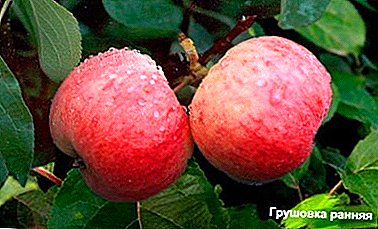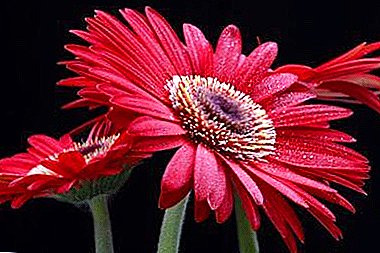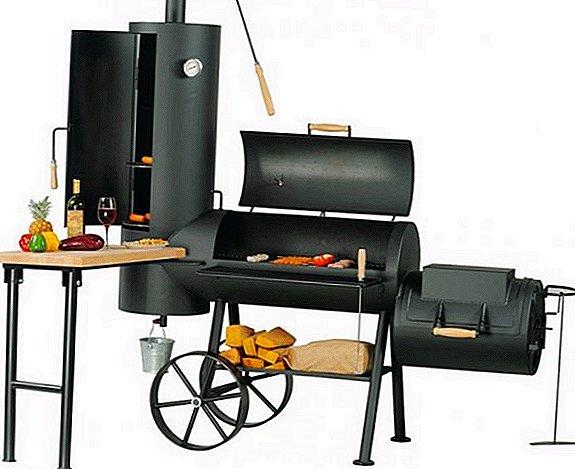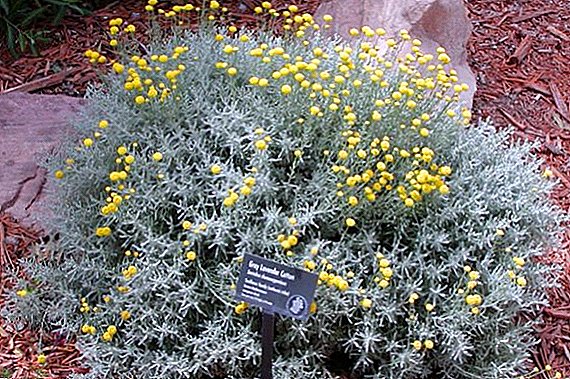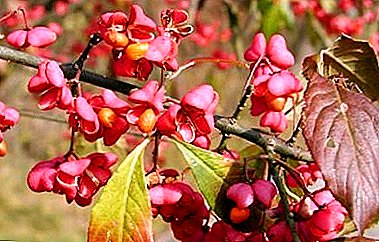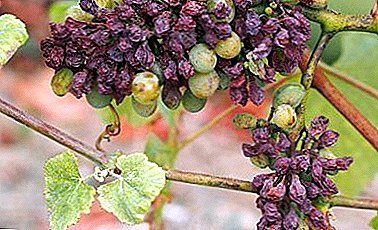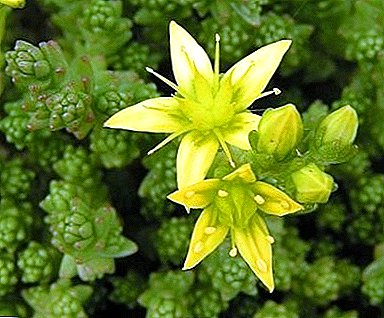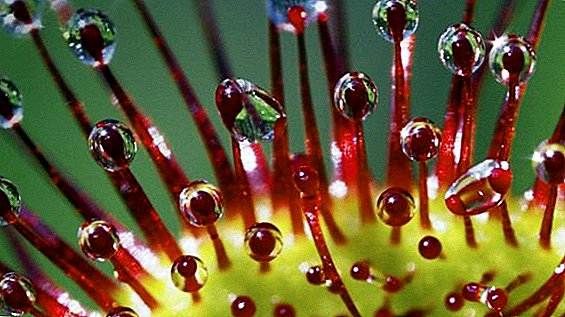 The sundew is a predator plant that catches its victims with the help of sticky droplets on the leaves, although at first glance it seems fragile and harmless.The structure of the sundew traps is rather unusual. These are the peculiar heads of a round form covered with hairs on which tips dew drops sparkle. This dew exudes a fragrance that attracts insects.
The sundew is a predator plant that catches its victims with the help of sticky droplets on the leaves, although at first glance it seems fragile and harmless.The structure of the sundew traps is rather unusual. These are the peculiar heads of a round form covered with hairs on which tips dew drops sparkle. This dew exudes a fragrance that attracts insects.
The flowed insect instantly sticks to sticky dew, after which the sheet plate moves and moves so that the insect moves to the central part of the leaf. There are the main digestive villus plants. The victim is digested with the help of digestive enzymes in dew drops.
The leaf plate with the trapped prey inside is compressed until it receives all the nutrients. From the fly after such a disastrous encounter, only the chitinous shell remains. Then the sundew leaf straightens and waits for the next victim.
Did you know? An insect adhering to a drop of dew begins to desperately escape, but thereby only brings its death closer. The victim's movement signals the plant, which activates the other hairs - they reach for the food they have caught, and the leaf begins to fold.
Optimum conditions for growing sundews
 Perhaps the cultivation of predatory sundew at home, where it can be an annual or perennial plant. As a houseplant, it is very whimsical, and not many succeed in its breeding.
Perhaps the cultivation of predatory sundew at home, where it can be an annual or perennial plant. As a houseplant, it is very whimsical, and not many succeed in its breeding.
Growing sundew requires compliance with some rules, otherwise it can be ruined. There are different types of this plant, and the rules for caring for each can vary, but there are also general ones.
The soil
Predatory plants need special soil. This nuance must be considered when planting and transplanting this plant. As already mentioned, the sundew in nature grows in swampy areas, respectively, in room conditions, it needs to try to provide a familiar substrate.
The soil should be light, poor, sour. The optimal ground for the sundew is a mixture of peat and quartz crumb or sand. To prepare the mixture, it is necessary to take peat - 3 parts, sand - 2 parts and perlite - 1 part.
It is better to take quartz sand, as usual may contain mineral elements. If there is no quartz sand, you can only take perlite.
Location and lighting
 Sundews prefer well-lit and constantly ventilated places. A good location would be a bit distant from the south window. It is not recommended to place a plant pot on the window itself, as direct sunlight can leave burns on the leaves.
Sundews prefer well-lit and constantly ventilated places. A good location would be a bit distant from the south window. It is not recommended to place a plant pot on the window itself, as direct sunlight can leave burns on the leaves.
Shaded places are not suitable for sundews, in such conditions, it may die. Alternatively, the plant can be grown on a window sill, where direct sunlight hits only in the evening. You can use additional lighting to provide comfortable conditions for the dew-through, but you do not need to turn it directly to the light source. When using artificial lighting it is also necessary to observe the precautions, as well as with direct sunlight.
Temperature
Growing in the tropics, sundews need a temperature not lower than + 18 ° C, including during the winter period. Plants of this species, which are found in northern latitudes, can live at a cooler temperature - from +5 ° С.
At home, the sundew need to provide a temperature of + 13-20 ° C. In winter, the temperature will be + 7-10 ° C. These temperature regimes for some species may vary slightly, so it is recommended to study the growing conditions for a particular type of sundew when purchasing.
Rules for the care of "predator"
Caring for sundew at home has its own characteristics. The rules must be studied and observed, as they play an important role for the life of a plant, which is quite sensitive to the conditions of irrigation and air humidity.
Watering
Watering sundews should be abundant and frequent. It should not be allowed as excessive moisture, as the drying of the soil.
 A very important point: dew must be watered only with rain or distilled water, which should not contain any minerals. Tap water will kill the plant. When watering you need to follow, so as not to wet the leaves of sundew.
A very important point: dew must be watered only with rain or distilled water, which should not contain any minerals. Tap water will kill the plant. When watering you need to follow, so as not to wet the leaves of sundew.
Air humidity
The air humidity around the sundew should be at least 60-90%. The plant loves high humidity, so water should be constantly in the pan, the level of which is about 1-2 centimeters.
Alternatively, the sundew can be settled in a shallow aquarium, the bottom of which is covered with moss. A moss pot can be put on the moss, and to recreate a good level of humidity, water can be poured into the tray and the moss.
Important! The aquarium should not be deep so that the plant protrudes beyond its edges. The sundew should not be placed near the glass, because if the sunlight passes through it, the leaves of the plant will be damaged.
Another important point: sundew can not be sprayed.
Do I need to feed
Artificial feeding is extremely undesirable for this predator. Due to their peculiarities, sundews can develop properly only if they produce food on their own. Interventions from outside only harm the plant.
In the warm season, the plant can be taken out on the street, so that it can catch food for itself. If there is confidence that the plant is starving, you can feed it with a front sight. But such dressing cannot be entered into the system.
Features of care in the winter
 In winter, plant growth slows down, but it does not hibernate. In some species, the leaves die off, but the plant still grows evenly, without a period of rest.
In winter, plant growth slows down, but it does not hibernate. In some species, the leaves die off, but the plant still grows evenly, without a period of rest.
In winter, the substrate in which the sundew grows should be slightly wet. The plant should be watered once a week or less.
As for the lighting, You can add it with lamps, as the plant may experience some lack of sunlight.
Important! Too warm temperatures in winter will be detrimental to the plant.
All the details of transplantation
Having bought an adult plant, there is no need to hurry with its transplant. Initially, the soil must be moistened and give the dewberry time to get used to the new habitat conditions.
Transplantation is recommended once every 1-2 years. The most favorable period is spring, when the plant wakes up and its growth is activated.
For sundews necessarily need a pot with a hole at the bottom. It is important that the container was a light shade and not less than 10 cm tall. The light color of the pot prevents overheating of the earth in it. Plant one bush in the pot, as the sundew has long roots, and they quickly grow.
In the process of transplanting the plant is carefully removed from the old soil, holding it by the leaves. New prepared substrate for transplant moistened with distilled water, they make a deepening in it and place the sundew in such a way that all its roots are underground.
 After transplanting dews for a few days lost dew from the leaves, which is considered the norm. During this period, the plant may be in light penumbra. You can also put it under a cap for several days to maintain the level of humidity and prevent shock. Within a week, dew should reappear on the leaves of the plant.
After transplanting dews for a few days lost dew from the leaves, which is considered the norm. During this period, the plant may be in light penumbra. You can also put it under a cap for several days to maintain the level of humidity and prevent shock. Within a week, dew should reappear on the leaves of the plant.
Methods of breeding sundew
Propagation of sundew is done in several ways: dividing the root of the bush, leaf cuttings and seed method.
Dividing bush
It is best to divide the sundew bush in the spring when transplanting. Some species are capable of forming daughter outlets. They are separated from the parent bush and rooted in a separate container.
It is also possible to reproduce, dividing the main bush into parts and rooting them into different pots.
Cuttings
For reproduction leaf cuttings cut leaf. Then it can be divided into segments and placed in a wet substrate or on the moss. After that, the cutting is covered with glass or film and provide abundant watering. The first shoots should appear in 2 months, after which the plant is planted in a pot.
You can also use not leaf cuttings, and flower shoots. They need to be cut to the appearance of flowers, root the shoot into the ground and cut as close as possible to the base. Before rooting, the shoot can be temporarily placed in a mini-greenhouse.
Seeds
 Many species of dews can self-pollinate. When closing their flower is pollinated independently. Therefore, obtaining plant seeds is not at all difficult. They are numerous, small, black.
Many species of dews can self-pollinate. When closing their flower is pollinated independently. Therefore, obtaining plant seeds is not at all difficult. They are numerous, small, black.
How to grow a dewyant from seed:
- shallowly plant tiny seeds into the substrate;
- water the soil abundantly;
- cover the landing site with a glass bulb on top;
- provide good lighting;
- ensure good watering by immersing the pot in a container with water;
- after 2-5 weeks, shoots should appear;
- dive seedlings in separate pots.
Possible problems with growing sundew
 The main problem in growing sundews is rotting of the root system, which occurs with abundant watering and low temperatures. The plant becomes dull in color, the leaves and stem darken, and its growth is significantly slowed. Sometimes aphid or gray mold (botrytis) may appear from bogging up the soil.
The main problem in growing sundews is rotting of the root system, which occurs with abundant watering and low temperatures. The plant becomes dull in color, the leaves and stem darken, and its growth is significantly slowed. Sometimes aphid or gray mold (botrytis) may appear from bogging up the soil.
When anxious symptoms appear in a plant, it is necessary to immediately transplant it into a new pot and change the substrate. To combat aphids can use insecticide. As for insect infestation, it is impossible for a given predatory plant, since the sundew itself hunts them.
Problems in growing sundews are easy to avoid. providing the right care for her.
Did you know? The sundew digests a medium-sized insect for several days, after which it begins to hunt again.
Useful properties and application of sundew
This is an unusual predator plant that eats insects, found application in traditional medicine. Sundew grass collected during the flowering period was used in the treatment of cough and whooping cough.
 Sundew is also used in homeopathy. In folk medicine, there was the use of its catcher droplets - this juice of the plant's glands is used to get rid of warts. Inside, the sap of the plant is used as a diuretic and diaphoretic in fevers. On the basis of insectivorous sundews produce preparations for eye inflammation. Also The plant is one of the ingredients of Italian liqueur.
Sundew is also used in homeopathy. In folk medicine, there was the use of its catcher droplets - this juice of the plant's glands is used to get rid of warts. Inside, the sap of the plant is used as a diuretic and diaphoretic in fevers. On the basis of insectivorous sundews produce preparations for eye inflammation. Also The plant is one of the ingredients of Italian liqueur.
Sundew is an unusual plant. It has a specific appearance, and it is interesting to watch him. Proper care will ensure the emergence of new leaves and an abundance of droplets on them, which is a sign of plant health.


